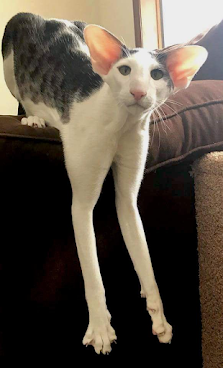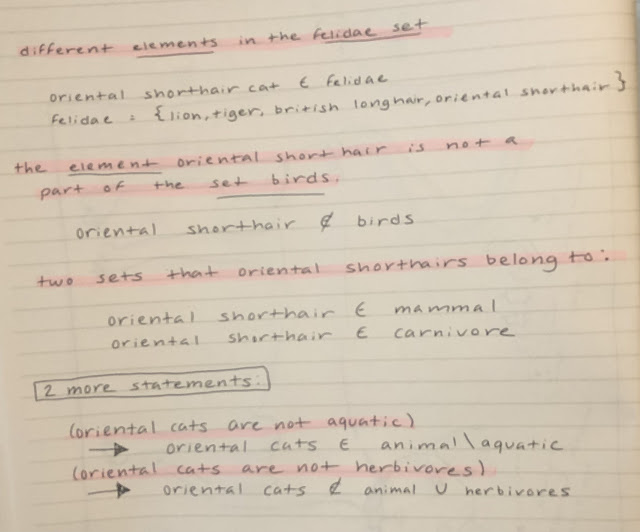a classification conversation!
(Oriental Shorthair Cat, Felis Catus)
 (Dobby Cat, https://www.pinterest.com/pin/363806476146313383/)
(Dobby Cat, https://www.pinterest.com/pin/363806476146313383/)
 (Bicolor male, 2007, Wikipedia, https://en.wikipedia.org/wiki/File:Trey_mississippi.jpg)
(Bicolor male, 2007, Wikipedia, https://en.wikipedia.org/wiki/File:Trey_mississippi.jpg)
In order to prepare for this Unit 1 Action Project (for our Population class), our class explored taxonomy and other aspects of classifying organisms. More specifically, we applied our knowledge of classification (primarily morphological features) and mathematical notation to create a physical rendition of our chosen organism. I already had an organism in mind: the Oriental Shorthair cat. Initially, I was intrigued by the elegant and “extreme” features of this breed of domestic cat. I began with a sketch of my rendition, making sure to incorporate all elements pertaining to the taxonomic hierarchy (kingdom, phylum, class, order, family, genus, and species):
Part of the “classification conversation” has to do with comparing features and characteristics of different organisms. We have to ask questions about what makes a group or category different from one another. I was curious about the specifics of what can separate members of the same family, so I decided to focus on the felidae family. Furthermore, I found that the biggest factors that set the felidae family apart are the big and little cats. Small cats that fall under felis catus can not roar and are domesticated. Big cats that can roar and thrive more in the wild are under an entirely different genus/species. The morphology of these animals can differ depending on both species and breed. For example, both the Oriental Shorthair cats and British Longhair cats are domestic, small cats (who act and appear very different from the lion). However, Orientals have “extreme features” like long legs, neck, and body, as well as large ears and a triangular head. On the other hand, British Longhair cats fit the more traditional idea of house cats. Below are more details about the comparison of these members of the felidae family:

Along with the venn diagram format of comparing and contrasting, we practiced using set notation to categorize elements into sets. In the case of my statements below, there are a variety of sets to depict which ones the Oriental Shorthair cat may or may not belong to:

Additional information about the Oriental Shorthair cat includes important details about their history. These cats are highly intelligent, playful, and affectionate. They resulted from crossbreeding Siamese cats with several other types of cats during WW2 (Puisis, 2019). Their coats come in hundreds of color combinations, but their eyes are generally green. A common result of breeding animals are the consequential health complications. While I was initially fascinated by their peculiar attributes, I found that the Oriental Shorthair cats are not immune to these health problems. Similar to the Siamese cats, they are susceptible to “bladder stones, crossed eyes, and mast cell cancer,” among other conditions. The exploitation of animals and the breeding is evident in much of the genetic research and the general complications. Hopefully, more attention will be highlighted on the implications of cats and other animals, such as the neurologically impaired corkscrew snakes or “purebred dogs” with heart defects, epilepsy, etc (PETA).
Based on the taxonomy table I compiled, I incorporated the morphological and differentiating features of the Oriental Shorthair cat. The green labels pertain more to the characteristics of each taxonomic level, and I made sure that the main cat was the largest aspect of the final piece. It features moveable legs to depict the long legs categorized by these cats. Additionally, I made sure that this cat had large ears and a more triangular head than the other drawings. This is because all domestic cats, regardless of their breed, are part of the same species (National Geographic), so I wanted to detail the traits of this specific breed for the “main cat.”
Works Cited
“Breeders.” PETA, 8 June 2020, https://www.peta.org/issues/animal-companion-issues/pet-trade/breeders/.
Menotti-Raymond, M, et al. “Widespread Retinal Degenerative Disease Mutation (RdAc) Discovered among a Large Number of Popular Cat Breeds.” Veterinary Journal (London, England : 1997), U.S. National Library of Medicine, Oct. 2010, https://www.ncbi.nlm.nih.gov/pmc/articles/PMC6984347/.
“Oriental Shorthair - Alchetron, the Free Social Encyclopedia.” Alchetron.com, 1 July 2018, https://alchetron.com/Oriental-Shorthair.
“Oriental Shorthair.” Daily Paws, https://www.dailypaws.com/cats-kittens/cat-breeds/oriental-shorthair.
Puisis, Erica. “Learn All about the Oriental Shorthair.” The Spruce Pets, The Spruce Pets, 13 Dec. 2019, https://www.thesprucepets.com/oriental-shorthair-cat-breed-profile-4774945.
In order to prepare for this Unit 1 Action Project (for our Population class), our class explored taxonomy and other aspects of classifying organisms. More specifically, we applied our knowledge of classification (primarily morphological features) and mathematical notation to create a physical rendition of our chosen organism. I already had an organism in mind: the Oriental Shorthair cat. Initially, I was intrigued by the elegant and “extreme” features of this breed of domestic cat. I began with a sketch of my rendition, making sure to incorporate all elements pertaining to the taxonomic hierarchy (kingdom, phylum, class, order, family, genus, and species):
Part of the “classification conversation” has to do with comparing features and characteristics of different organisms. We have to ask questions about what makes a group or category different from one another. I was curious about the specifics of what can separate members of the same family, so I decided to focus on the felidae family. Furthermore, I found that the biggest factors that set the felidae family apart are the big and little cats. Small cats that fall under felis catus can not roar and are domesticated. Big cats that can roar and thrive more in the wild are under an entirely different genus/species. The morphology of these animals can differ depending on both species and breed. For example, both the Oriental Shorthair cats and British Longhair cats are domestic, small cats (who act and appear very different from the lion). However, Orientals have “extreme features” like long legs, neck, and body, as well as large ears and a triangular head. On the other hand, British Longhair cats fit the more traditional idea of house cats. Below are more details about the comparison of these members of the felidae family:
Along with the venn diagram format of comparing and contrasting, we practiced using set notation to categorize elements into sets. In the case of my statements below, there are a variety of sets to depict which ones the Oriental Shorthair cat may or may not belong to:
Additional information about the Oriental Shorthair cat includes important details about their history. These cats are highly intelligent, playful, and affectionate. They resulted from crossbreeding Siamese cats with several other types of cats during WW2 (Puisis, 2019). Their coats come in hundreds of color combinations, but their eyes are generally green. A common result of breeding animals are the consequential health complications. While I was initially fascinated by their peculiar attributes, I found that the Oriental Shorthair cats are not immune to these health problems. Similar to the Siamese cats, they are susceptible to “bladder stones, crossed eyes, and mast cell cancer,” among other conditions. The exploitation of animals and the breeding is evident in much of the genetic research and the general complications. Hopefully, more attention will be highlighted on the implications of cats and other animals, such as the neurologically impaired corkscrew snakes or “purebred dogs” with heart defects, epilepsy, etc (PETA).
Works Cited
“Breeders.” PETA, 8 June 2020, https://www.peta.org/issues/animal-companion-issues/pet-trade/breeders/.
Menotti-Raymond, M, et al. “Widespread Retinal Degenerative Disease Mutation (RdAc) Discovered among a Large Number of Popular Cat Breeds.” Veterinary Journal (London, England : 1997), U.S. National Library of Medicine, Oct. 2010, https://www.ncbi.nlm.nih.gov/pmc/articles/PMC6984347/.
“Oriental Shorthair - Alchetron, the Free Social Encyclopedia.” Alchetron.com, 1 July 2018, https://alchetron.com/Oriental-Shorthair.
“Oriental Shorthair.” Daily Paws, https://www.dailypaws.com/cats-kittens/cat-breeds/oriental-shorthair.
Puisis, Erica. “Learn All about the Oriental Shorthair.” The Spruce Pets, The Spruce Pets, 13 Dec. 2019, https://www.thesprucepets.com/oriental-shorthair-cat-breed-profile-4774945.



Comments
Post a Comment